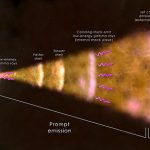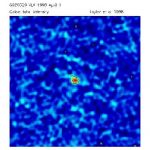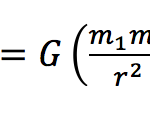Glossary of Radio Astronomy Terms
Galactic Center:
The central region of a galaxy characterized by high densities of stars. The center might contain a supermassive black hole. In the case of the Milky Way, there is a supermassive black hole at the center of the galaxy called Sagittarius A*.
Galactic Halo:
The spherical distribution of old stars and globular clusters that surround a galaxy. (see globular clusters for more)
Galactic Nucleus:
A tight concentration of stars, and in some cases a supermassive black hole, found at the innermost regions of a galaxy.
Galaxy:
A large body of gas, dust, stars, and their companions (Planets, asteroids, moons, etc.) held together by their mutual gravitational attraction. They are grouped into three main categories: spiral galaxies, elliptical galaxies, and irregular galaxies. (see below) Another class of galaxies is peculiar galaxies, which are thought to be distorted versions of normal galaxies.

Gamma rays:
Gamma-rays have some of the smallest wavelengths and highest amount of energy compared to all other waves on the electromagnetic spectrum.

Gamma-ray Burst:
A powerful event where the powerful energy of a black hole is discharged. The gamma-ray emission can last anywhere from a few minutes to several hours, yet the afterglow from the burst can last for more than a year, which makes long-term observations possible.

General theory of relativity:
The theory of gravitation developed by Albert Einstein. The theory discusses the nature of black holes, consequences for the bending of light by massive objects, and the fabric of space and time.

Geodesy:
A technique used to study the motion of the Earth’s tectonic plates through the use of an interferometer. (see below for definition of an interferometer)
Giant Molecular Cloud (GMC):
Massive clouds of gas in interstellar space composed primarily of hydrogen molecules. These clouds have enough mass to produce thousands of stars and are frequently the sites of new star formation.

Giant Star:
A star with a significantly larger radius and higher luminosity than a dwarf star. (See dwarf star for more)

Gigahertz (GHz):
A unit of measurement representing a frequency of one billion cycles per second.
Globular Cluster:
A spherical star cluster containing 50,000 to 1 million stars. Some of the older, metal-poor global clusters are thought to be the left over building blocks of a galaxy’s formation.

Gravity:
A mutual physical force of nature that causes two bodies to attract each other.

Gravitational Lens:
The effect when light from a distant object, such as a galaxy, is bent by the gravity of a massive object, such as another galaxy, before it reaches the Earth. If the two objects are perfectly aligned, the light from the distant object appears as a ring, to observers on Earth. This phenomenon is called an Einstein Ring, since its existence was predicted by Einstein in his theory of General Relativity. (see definition above)
Green Bank Observatory:
The first facility in the United States dedicated to radio astronomy. Because of this observatory, the National Radio Astronomy Observatory was created. This facility was also the first national laboratory open to scientists from around the world.
Galaxy cluster:
A galaxy cluster, or cluster of galaxies, is a structure that contains 100s to 1,000s of galaxies all bound together by gravity. They are among the largest objects in the known universe.







